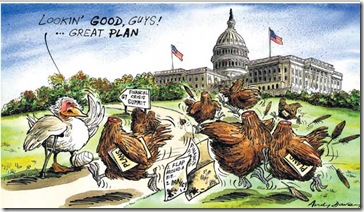Well, that worked. Again. The world's political power-lusters and so-called financial experts are ferociously bailing out and bailing out, and each time they bail the leaks in their creaking fractional reserve system only get bigger and the markets give their own short-term assessment (either up or down) and medium-term estimate of their success: they keep going down.
And meanwhile they sacrifice any chance of long-term prosperity by the short-term hope that something they might do now may somehow have some effect that lasts longer than tomorrow's headlines.
But it can't. As I said before, they're pouring billions of dollars down a black hole of failed (macro)economic theory.
Feeding financial failure today with more and more paper in the expectation of success next week is like feeding a whale a tic-tac in the hopes he won't swallow you instead. It's the wrong treatment for the wrong symptoms, and fails to address the cause.
 No wonder they all look like chickens with their heads cut off.
No wonder they all look like chickens with their heads cut off.
There was a time, back before Paul Krugman got a job there as a columnist slagging off capitalism, when the New York Times economics commentator not only understood the most basic lesson of free market economics -- a lesson that today's "financial experts" seem oblivious to --but he also wrote a book about it called, simply enough, Economics in One Lesson. The one lesson delivered in that 1946 book, written by then-Times editorial writer Henry Hazlitt is this :
:
the art of economics consists in looking not merely at the immediate but at the longer effects of any act or policy; it consists in tracing the consequences of that policy not merely for one group but for all groups.
Read that again. "The art of economics consists in looking not merely at the immediate but at the longer effects of any act or policy; it consists in tracing the consequences of that policy not merely for one group but for all groups." That's the lesson -- simple in essence, but profound in its implications.
Scott Kjar delivers Hazlitt's lesson for today's "experts" here. In short, if they looked beyond their noses they would discover a. that their "bad credit" will only drive out good producers, and b. that the argument that the government is somehow pumping new capital into the market is absurd --
Government is actually borrowing the money from the capital markets that it is in turn injecting into the capital markets. There is no additional source of funding; there is only a diversion of funds from more-productive outlets to less-productive outlets, with government acting as the middleman.
So when Henry Paulson argues that it is necessary to pump money into credit markets to prevent them from freezing up, he doesn't bother to realize that the money he pumps into the credit markets is coming directly out of the very same credit markets. He is doing little more than rearranging the deck chairs on the Titanic; shuffling the money from one set of financial intermediaries to another does not increase either liquidity or solvency. It merely delays the problem for a few brief moments.
Paulson and Bernanke and their European confreres are running faster and faster just keep going backwards -- as they will until they learn the fundamental lesson taught to succinctly by Henry Hazlitt over sixty years ago.
NB: Just to help you learn and apply the lesson yourself, the Mises Institute has posted a series of twelve video interviews with leading Austrian Economists, one interview for each chapter. Take time over the weekend to listen and learn. George Reisman's Minimum Wage Laws in particular is a classic. They'd love it over at The Sub-Standard blog, where they call for a huge hike in the minimum wage at the very moment when we're all about to plunge into depression.
No comments:
Post a Comment